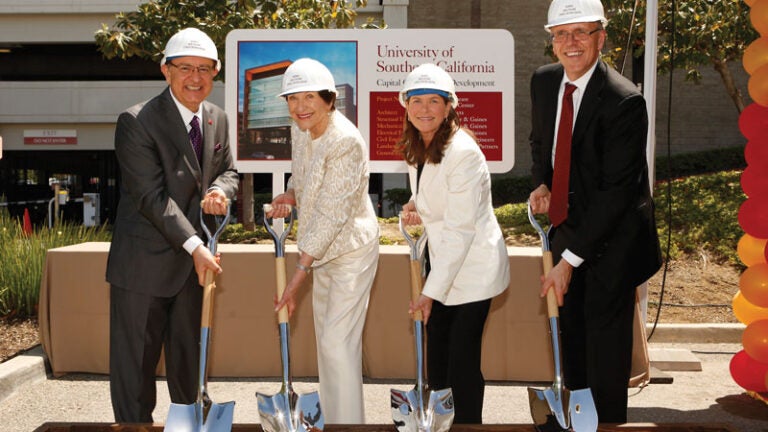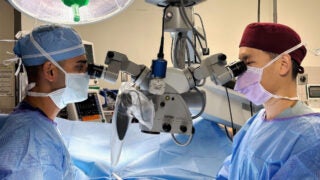
Ground is broken for new Norris Healthcare Consultation Center. All photos courtesy of USC University Archives
and Health Sciences Public Relations and Marketing
Lives in the Balance
Physicians are now treating, even curing, some cancers once thought to be untreatable. See what’s ahead at USC Norris.
She didn’t expect to develop colon cancer, and she didn’t expect to end up at USC Norris Comprehensive Cancer Center. No one does. But for Nancy Bernstein, it’s been a very good place to be.
“I needed to fight,” says Bernstein, a producer at DreamWorks Animation and a patient of oncologist Heinz-Josef Lenz at USC Norris. “Dr. Lenz’s passion for curing cancer is just infectious, and made me believe that I would have a unique partner in fighting my cancer.”
Three years after her cancer was diagnosed, Bernstein is still living with metastatic cancer and rallying everyone she can to support colorectal cancer research at USC Norris. She’s just one of the believers who has seen firsthand how USC Norris physicians constantly push to come up with better treatments. The doctors work closely with scientists in the same center, applying the latest technology to understand and stop cancer.
“Our patients are getting cutting-edge therapy for every possible cancer type,” says Stephen Gruber, USC Norris’ director.
Patients like Bernstein all have their own stories to tell, but each one also is part of a long USC Norris legacy.
USC Norris was among the first eight comprehensive cancer centers designated by the National Cancer Institute in 1973, two years after President Richard Nixon signed the National Cancer Act. As a comprehensive cancer center, it fights cancer on several fronts: in the lab through research, in the clinic through care, and in the community through prevention and education.
“What’s special about USC Norris is its commitment to compassionate care combined with exceptional innovation,” Gruber says. “We all share an absolute passion and mission to make cancer a disease of the past while caring for each individual patient.”
USC Norris’ 40 years span major inroads into cancer, from developing important drugs to identifying ways to prevent the disease. But what was once a quest for a magic bullet against cancer has shifted to a steady march to defuse it through thousands of small scientific victories. At USC Norris, Keck School of Medicine of USC scientists and doctors continue to tackle the disease by studying it, treating it and finding ways to keep it away.
They’ll do it knowing that people like Nancy Bernstein depend on them.
Know thy enemy
Today, understanding cancer means deciphering the DNA mutations that are often its source. “All cancer starts with an alteration of the DNA,” says molecular biologist Michael Lieber, co-leader of USC Norris’ molecular genetics program.
These mutations can happen in a variety of ways. Some people inherit genetic mistakes from their parents. Other DNA damage occurs throughout life—such as when cells make a sort of “typo” copying their DNA. These mutations can change a cell’s life plan, causing it to grow and divide when it shouldn’t, and that can cause cancer.
Understanding how DNA errors occur and are repaired gives scientists ideas about how to kill cancer cells without injuring normal cells. Lieber’s work with acute lymphoblastic leukemia, or ALL, the most common cancer in young children, is a good example.
Cancerous ALL cells need a molecule called Artemis to repair a DNA lesion specific to those tumor cells. Lieber figures if he can turn of Artemis, the cancer won’t be able to maintain its DNA. The genes should fall apart, killing the cancer. Normal cells can live without Artemis, so they should be OK.
The NCI saw the plan’s potential, backing it through the NCI Experimental Therapeutics Program. The aim: find an Artemis-blocking drug and get it to patients as soon as possible.
But there’s more to cancer than DNA mutations. DNA strands sometimes have little chemical tags, called methyl groups, attached to the DNA. The methyl groups can act like stop signs, turning of the gene they’re attached to. Sometimes having a gene turned on or of at the wrong time, even if there is no mutation, can promote cancer. All of these sorts of changes that happen to a cell’s DNA are known as its epigenome, and the study of these changes is called epigenetics.
Cancer researchers at USC and elsewhere want to understand all the genetic and epigenetic changes to DNA that can cause cancer. One project, which Gruber wants to expand, is a tissue repository to catalog and save bits of tumors from Los Angeles County cancer patients so scientists can sift through the samples for clues.
In addition, USC is leading a major component of The Cancer Genome Atlas (TCGA), a nationwide program to chart key changes to various cancers’ molecular makeup, including DNA methylation. The project aims to map at least 20 types of cancer by the end of this year. All TCGA epigenomic data production happens in the USC Epigenome Center, occupying the ground for of USC Norris’ newest research tower. High-tech robots and other machines sequence samples of cancerous cells, while scientists strive to decipher what those sequences might mean.
So far, those machines have identified methyl patterns on more than 9,000 of a planned 10,000 cancer samples, says USC Epigenome Center Director Peter Laird. That’s a lot of data. To crunch it all, the researchers draw on the computational equivalent of 650 laptops at USC’s Center for High-Performance Computing downtown.
“These data will be mined for years and years to come,” Laird says.
Targeted treatments
One feature researchers expect to see through TCGA is that different mutations or epigenetic changes underlie different cancers. They’ll use this information to design treatments that kill cancers with specific genetic or epigenetic changes, in an approach called personalized or precision medicine.
“It is no longer a one-size-fits-all approach to cancer therapy,” Gruber says. “We are tailoring the treatment to the patient and the tumor.”
Precision medicine is already the standard of care for many cancers, including breast, lung and colon cancer, Gruber says. For example, if a breast tumor has turned on a gene called HER2, doctors can treat it with a drug called Herceptin that seeks out those HER2-making cancer cells.
HER2 is just one gene. In the near future, Gruber predicts, all cancer patients at USC Norris will undergo DNA sequencing to identify their tumor’s specific weaknesses. Ten their doctors can select treatments from a menu of medicines that exploit these weaknesses.
Sometimes that genetic analysis might indicate the best course of treatment is no treatment at all. For example, epidemiologist Mariana Stern and others are investigating which prostate tumors are likely to grow dangerously and which will remain harmless. Men with low-risk cancers might benefit from regular testing to monitor the cancer, rather than aggressive treatment like prostate removal.
In addition to their personalized nature, future treatments will probably fight cancer several ways, suggests Robert Seeger, a USC Norris member and pediatric oncologist at Children’s Hospital Los Angeles. He’s interested in not only killing cancer but also making the “neighborhood” around the cancer inhospitable for further growth.
Scientists call this neighborhood the tumor’s microenvironment, and they’ve only been studying it for the past 10 to 15 years, Seeger says. Seeger, who grew up on an Oregon farm, likes to refer to cancer as a seed and its microenvironment as the soil. If the soil is no good, he says, the seed won’t grow.
A big part of the microenvironment comes from the body’s immune system, which can either help or hinder a tumor’s growth. Seeger is developing a three-part approach to boost the tumor- fighting arm of the immune system at the same time as he directly targets neuroblastoma, a childhood cancer of nerve cells that often occurs near the kidneys.
Part one of the treatment will be an antibody that directly binds to the neuroblastoma cells—the seeds. The second part would act on the soil, aiming to boost a type of anti-tumor immune cell called natural killer, or NK, cells. Seeger and colleagues plan to harvest a patient’s NK cells from a blood sample and grow them in the lab, making them highly active. “They’re the hottest killers I’ve ever seen,” he says. The doctors will inject these cells back to the patient, along with part three, a drug that stimulates the NK cells even more.
Seeger expects a clinical trial of the three-part treatment to start this year, managed by a national consortium in collaboration with MD Anderson Cancer Center in Houston. If it works, it could be approved for general use as early as the dawn of the 2020s.
Avoid the battle
The best way to beat cancer is to keep it away in the first place, and precision medicine can help here too, says USC epidemiologist Jonathan Samet, Flora L. Tornton Distinguished Chair of Preventive Medicine. In a couple of decades, getting a checkup might include a personalized risk profile, based on your genes, for cancer and other diseases. If you’re at high risk for one or another cancer, doctors could watch extra-carefully to catch it early.
There might even be medicines that would protect high-risk people from certain cancers, Samet speculates. This would be similar to the way statins protect people with high cholesterol from future heart disease.
In some cases, preventive therapies for cancer already exist. For example, certain people have mutations, or?too many silencing methyl tags, in a gene?called MLH1. MLH1 protects cells from?DNA damage and fights cancer, so having?it turned of means a high risk for cancer of?the colon, uterus and ovaries.
But for people in that situation, simple treatments can drastically reduce their risk of getting cancer. Birth control pills minimize risk of uterine and ovarian cancer. And regular colonoscopies, with removal of polyps before they turn cancerous, slash colon cancer risk by 65 percent, Gruber says.
The next stage
“We’re now treating, even curing, some can?cers that were thought to be untreatable,”?Gruber says. “In 40 years, I predict that we?will be looking back at our success in converting cancer into a manageable disease.”
Many more of the cancer patients in the USC Norris waiting room will become longtime cancer survivors. They may be cured altogether, or effectively controlling their disease, the way people with diabetes manage their condition now.
“I have stage IV cancer. That means there’s no cure right now,” Bernstein says. “But that doesn’t mean I can’t beat the odds that I was originally given, and if somebody’s going to help me do that, it’s going to be Dr. Lenz and USC.”
For now, USC’s fight song sums up the center’s approach and its promise to patients. “Fight on,” Gruber says. “Fight on.”
You can support USC’s cancer-fighting reaserch at cancer.keckmedicine.org/giving/donate/ or by contacting USC Norris at (323) 865-0700 or norrisdev@usc.edu. Read about treatment at cancer.keckmedicine.org. Learn more about Nancy Bernstein at calltocure.org.
A Look Back: Brian Henderson
Professor Brian Henderson served as USC Norris’ director from 1983, when its hospital opened, until 1994. Henderson recently reminisced about the center’s history.
Treatment with Heart
We wanted a different kind of hospital, where you could feel the compassion. An environment that made people feel glad they’re here, that it’s a safe place, that they’re going to get good care.
“If you came in as a patient, you saw a nurse, and she stayed with you. The next day, she was back again. That personalized care made us a little different from everybody else.”
Collaborating for Cures
“We had to get everybody to work together—the surgeons, the radiation therapists, the oncologists—to agree on approaches to both research and therapy. At the time that was fairly new. I had to knock some heads together to get surgeons to work with nurses, for example. Now we take it for granted.”
Famous Visitors
“Cardinal Timothy Manning served in Los Angeles in the ’70s and early ’80s. [First serving as archbishop, Manning later was elevated to cardinal.] He became ill with lung cancer. He came to the Norris, and immediately the Cardinal felt this was a safe place.
“During his hospitalization, Mother Teresa happened to stop in LA, and she came to?see the Cardinal. God, [she was] short. But [she had] these intense eyes. She gave me a medal of the Virgin Mary and asked, ‘If any of my sisters need help, Doctor, will you take care of them?’ I said sure. What else can you say?”
Hear more memories of USC Norris on video.



